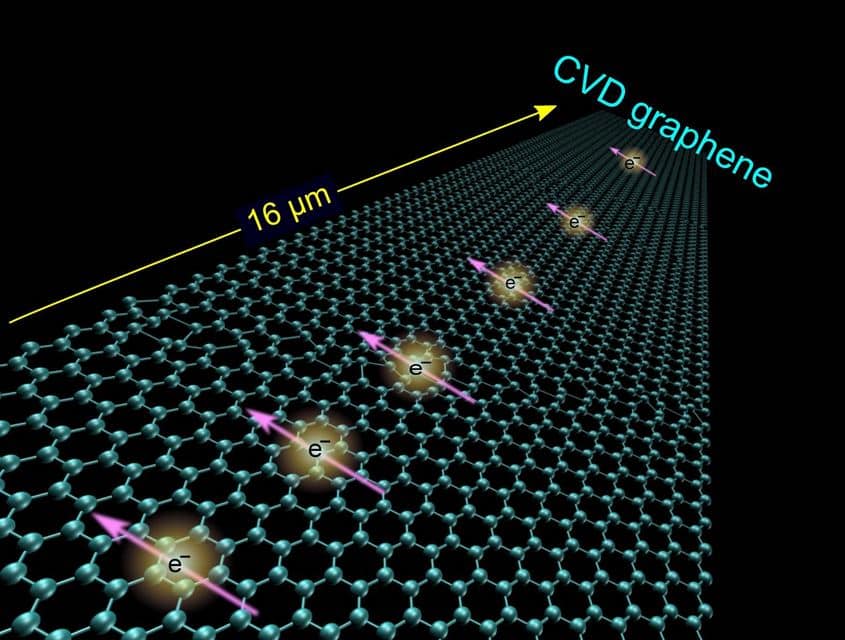Graphene, which is 100 times stronger than steel, and conducts heat and electricity with spectacular efficiency, is set to take spintronic devices to the next level, opening opportunities for the manufacturing of much faster and vastly more energy-efficient processors and memory in computers, say Swedish researchers.
Large area graphene can maintain electronic spin over a prolonged period, and communicate it over massively greater distances than the scientific community had previously thought feasible.
Researchers at Chalmers University of Technology, Gothenburg, Sweden, have written about their latest study in the journal Nature Communications.

In graphene, electrons maintain their magnetization, their spin (pink arrows) much longer than they do in ordinary conductors such as aluminium and copper. (Image: M Venkata Kamalakar et al)
Associate Professor, Saroj Prasad Dash, who led the study, said:
“We believe that these results will attract a lot of attention in the research community and put graphene on the map for applications in spintronic components.”
Spintronics (word is a blend of: spin-transport-electronics), also known as fluxtronic or spinelectronics, is the study of the intrinsic spin of the electron and its associated magnetic movement, as well as its fundamental electronic charge, in solid-state devices.
In spintronics, the spins are not only manipulated by magnetic fields as in older magetoelectronics, but also by electrical fields.
Spintronics is already being utilized in advanced hard drives for storing information and magnetic RAM (random access memory).
But here, the spin-based information only requires movements of a few millions of a millimetres, which is lucky as spin is an electron property that in most materials is very fragile and short-lived.
Spintronics accelerates processor speeds
There are some important benefits in exploiting spin as a carrier of data, rather than, or as well as electric charges. Spintronics could make processors work much faster, consuming far less energy than they currently do.
Graphene has the potential to extend the use of spintronics in the electronics industry, the researchers believe. The super-thin carbon film is not just an amazing electrical conductor, it also has the rare ability (in theory) of maintaining electrons with the spin intact.

Assistant Professor Saroj Prasad Dash. (Image: Chalmers)
Professor Dash commented:
“In future spin-based components, it is expected that the electrons must be able to travel several tens of micrometers with their spins kept aligned.”
“Metals, such as aluminium or copper, do not have the capacity to handle this. Graphene appears to be the only possible material at the moment.”
Very few companies currently produce graphene, using a number of different methods, with all of them in early phases of development. This means that today graphene is only obtainable in minute quantities, while larger graphene is made in a way that the quality is either poor or has other defects for the electronics industry.
Chemical vapour deposition (CVD) graphene
Researchers at Chalmers now question that assumption after carrying out their study. They performed their experiments using CVD graphene, which is produced through chemical deposition.
While the CVD method gives the graphene wrinkles, roughness and a number of other defects, it has some key advantages. It allows graphene to be produced on an industrial scale.
The researchers wrote:
“The CVD graphene can also be easily removed from the copper foil on which it grows and is lifted onto a silicon wafer, which is the semiconductor industry’s standard material.”
Even though the material currently being produced is far from perfect, the research team can now show parameters of a spin that are six times greater than those previously recorded for CVD graphene on a similar substrate.
First author, Venkata Kamalakar Mutta, who also works at Chalmers, said:
“This is promising because it suggests that the spin parameters can be further improved as we develop the method of manufacturing.”
No more reliance on semiconductors?
The aim is not just to send data in a new material or substitute semiconductors or metals with graphene, but to have an entirely new way of performing logical operations and storing information.
If this step is successful, it would leave digital technology’s reliance on semiconductors behind.
Prof. Dash explained:
“Graphene is a good conductor and has no band gaps. But in spintronics there is no need for band gaps to switch between on and off, one and zero. This is controlled instead by the electron’s up or down spin orientations.”
“A short-term goal now is to construct a logical component that, not unlike a transistor, is made up of graphene and magnetic materials.”
Prof. Dash and colleagues say a great deal of research still needs to be done before we know whether spintronics can eventually completely replace semiconductors.
The authors wrote:
“But graphene, with its excellent spin conduction abilities, is highly likely to feature in this context.”
Reference: M. Venkata Kamalakar, Christiaan Groenveld, André Dankert & Saroj P. Dash. “Long distance spin communication in chemical vapour deposited graphene.” Nature Communications. Published 10 April, 2015. DOI: 10.1038/ncomms7766.
